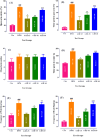6-Hydroxyflavanone treats anxiety and chemotherapy-induced neuropathy in Sprague-Dawley rats
- PMID: 39744130
- PMCID: PMC11688605
- DOI: 10.3389/fphar.2024.1486918
6-Hydroxyflavanone treats anxiety and chemotherapy-induced neuropathy in Sprague-Dawley rats
Abstract
Background: Cancer remains a predominant cause of death worldwide. The advent of effective chemotherapy has enormously decreased the mortality rate and increased the life expectancy of cancer patients. However, the adverse effects allied with chemotherapy contribute to the development of neurotoxicity, anxiety, and depression.
Objective: The dual effects of a novel flavanone, 6-hydroxyflavanone (6-HF), were investigated in treating chemotherapy-induced neuropathy along with anxiolytic propensity.
Methods: The anti-neuropathy propensity of 6-HF was evaluated utilizing the cisplatin-induced neuropathy (CIN) model, whereas its anxiolytic activity was evaluated utilizing anxiety models, such as the elevated plus maze test (EPM), the staircase test, and the open-field paradigm.
Result: Cisplatin administration induced static and dynamic allodynia in the rats. Concomitant administration of 6-HF and cisplatin for four successive weeks remarkably reduced the chemotherapy-induced mechanical allodynia, evident from an elevation in the paw withdrawal threshold (PWT) and paw withdrawal latency (PWL). The anxiolytic-like activity of 6-HF in the EPM apparatus was confirmed by the increased number of entries in the open arm and time spent at the central platform, which was further confirmed by the enhanced head-dipping frequency in the same assay. A decrease in rearing behavior of the mice without suppression of the steps ascended further assured the anxiolytic-like potential of 6-HF. Additionally, the animals under investigation spent more time at the intersection of the open-field apparatus, further confirming the anxiolytic potential of 6-HF.
Conclusion: 6-HF might be considered a potential therapeutic agent for counteracting two common adverse effects of chemotherapy, neurotoxicity and anxiety.
Keywords: 6-hydroxyflavanone; anxiety; cancer; chemotherapy; neurotoxicity.
Copyright © 2024 Akbar, Subhan, Qamar, Akbar, Shahbaz, Aamir, Siddique and Islam.
Conflict of interest statement
The authors declare that the research was conducted in the absence of any commercial or financial relationships that could be construed as a potential conflict of interest.
Figures



Similar articles
-
Efficacy of 2-Hydroxyflavanone in Rodent Models of Pain and Inflammation: Involvement of Opioidergic and GABAergic Anti-Nociceptive Mechanisms.Molecules. 2022 Aug 25;27(17):5431. doi: 10.3390/molecules27175431. Molecules. 2022. PMID: 36080199 Free PMC article.
-
Characterization of 6-methoxyflavanone as a novel anxiolytic agent: A behavioral and pharmacokinetic approach.Eur J Pharmacol. 2017 Apr 15;801:19-27. doi: 10.1016/j.ejphar.2017.02.047. Epub 2017 Feb 28. Eur J Pharmacol. 2017. PMID: 28257822
-
Efficacy of a topical gabapentin gel in a cisplatin paradigm of chemotherapy-induced peripheral neuropathy.BMC Pharmacol Toxicol. 2019 Aug 28;20(1):51. doi: 10.1186/s40360-019-0329-3. BMC Pharmacol Toxicol. 2019. PMID: 31462283 Free PMC article.
-
Chronic pregabalin treatment reduced anxiety, and acute pregabalin treatment increased depression-like behaviors in rats.BMC Pharmacol Toxicol. 2024 Oct 1;25(1):72. doi: 10.1186/s40360-024-00794-y. BMC Pharmacol Toxicol. 2024. PMID: 39354569 Free PMC article.
-
[Effects of moxibustion of "biaoben acupoint combination" on heart rate variability, atrial natriuretic peptide in the model rats of IBS-D complicated with anxiety].Zhongguo Zhen Jiu. 2023 Oct 12;43(10):1139-47. doi: 10.13703/j.0255-2930.20221129-k0004. Zhongguo Zhen Jiu. 2023. PMID: 37802520 Chinese.
References
LinkOut - more resources
Full Text Sources
Research Materials
Miscellaneous

